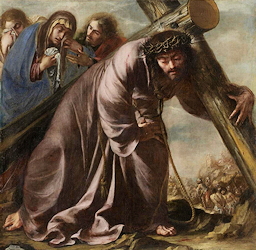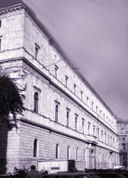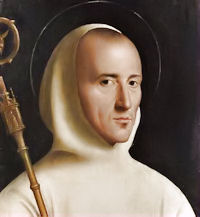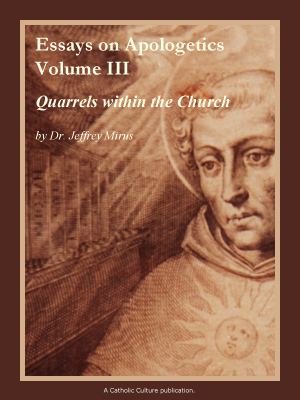Lent: April 1st
Tuesday of the Fourth Week of Lent
Other Commemorations: St. Hugh of Grenoble, Bishop (RM)
» Enjoy our Liturgical Seasons series of e-books!
The mercy of God is not an invitation to sin. He may forgive us and take away the punishment due to sin. But let us not take it as an encouragement to sin more freely. The warning which Christ has just given to the man cured of his long infirmity is also meant for us: “See, you are well again; now sin no more, for something worse may happen to you.” Christ demands a permanent and sincere conversion after we have received his forgiveness. —St. Andrew Bible Missal
St. Hugh of Grenoble (1053-1132) is commemorated in the Roman Martyrology. He was born in 1053 at Chateauneuf, France, and elected Bishop of Grenoble at the age of twenty-eight to purge the diocese of its disorders, and he occupied the see until his death fifty-two years later in 1132.
Meditation for Tuesday of the Fourth Week of Lent—Converting Our Hearts Every Day
The Season of Lent for every Christian should mark a turning point, accentuating that change in thought and life which becomes daily in those who truly wish to follow Jesus. In the Gospel the word “daily” is heard many times, for example speaking of the demands of discipleship, the Lord says: “every day” it is necessary to take up the cross and follow Him (cfr. Lk 9, 23). “Every day” is synonymous with “totality,” donation, which, because it is “daily," renews itself and never breaks up, never weakens. Just as running water flows continually and is always fresh and clear, so too the spiritual life: to maintain its vivacity it draws continually from the grace which flows from Jesus. In this sense we clearly understand the necessity to “pray without ceasing.”
A great temptation on the path of conversion is to stop, to “stagnate”: we remain as we are, we do not to renew ourselves, and in doing so deceiving ourselves and others with a “Christianity” consisting of habits and “goals reached”. The journey of Lent invites us to remove these illusions, the word of Jesus resounds louder than ever: “repent and believe in the Gospel”. To be authentic conversion should never stop; the true Christian experiences the dynamics of conversion, like walking behind Jesus, on a path which never stops because it is at the spiritual level, if we stop, we go backwards! “ 'Once the hand is laid on the plough, no one who looks back is fit for the kingdom of God.'” (Lk 9, 62).
 So as not to interrupt our conversion, our journey of 'becoming' Christians, the only possibility is daily conversion: denying ourselves, our ambitions every day, with the dynamic power of love. Selfishness has its own dynamics, which is also daily and drives us to satisfy 'ego'. Only the disciple who gives himself entirely to the Lord, day after day, becomes increasingly similar to his Master and lives in joy, light and love.
So as not to interrupt our conversion, our journey of 'becoming' Christians, the only possibility is daily conversion: denying ourselves, our ambitions every day, with the dynamic power of love. Selfishness has its own dynamics, which is also daily and drives us to satisfy 'ego'. Only the disciple who gives himself entirely to the Lord, day after day, becomes increasingly similar to his Master and lives in joy, light and love.
If a Christian says he has no joy, light or love then he must make a profound examination of conscience to discern areas where the power of selfishness prevails over the dynamics of conversion.
It is not God who is sparing with himself, or who hesitates to give Himself to us, it is man, as St Teresa of Avila says so well: “ If we attain to the perfect possession of this true love of God, it brings all blessings with it. But so niggardly and so slow are we in giving ourselves wholly to God that we do not prepare ourselves as we should to receive that precious thing which it is His Majesty's will that we should enjoy only at a great price.” (Life, chapter 11, paragraph 1).
Dying to self costs, but it obtains the greatest result: it allows Jesus to live in us. In fact there can be no dynamics of conversion, without daily “renouncing self" precisely to live for Jesus. The Word of God says clearly that only those who lose themselves, who give themselves entirely to God, truly find Him and enjoy Him here on earth: “ If, however, from there you start searching once more for Yahweh your God, and if you search for him honestly and sincerely, you will find him.” (Deut 4, 29). The Lenten journey is therefore a path of self-giving and trusting in God which culminates at Easter with new birth in Jesus. The Holy Father, Pope Benedict XVI, describes this dynamics with the following illuminating words: “ Jesus' invitation to take up one's cross and follow him may at first sight seem harsh and contrary to what we hope for, mortifying our desire for personal fulfilment. At a closer look, however, we discover that it is not like this: the witness of the saints shows that in the Cross of Christ, in the love that is given, in renouncing the possession of oneself, one finds that deep serenity which is the source of generous dedication to our brethren, especially to the poor and the needy, and this also gives us joy. The Lenten journey of conversion on which we are setting out today together with the entire Church thus becomes a favourable opportunity, "the acceptable time" (II Cor 6: 2) for renewing our filial abandonment in the hands of God and for putting into practice what Jesus continues to repeat to us: "If any man would come after me, let him deny himself and take up his cross and follow me" (Mk 8: 34) and this is how one ventures forth on the path of love and true happiness. (…)let us ask Our Lady, Mother of God and of the Church, to accompany us on our way through Lent, so that it may be a journey of true conversion. May we let ourselves be led by her, and inwardly renewed we will arrive at the celebration of the great mystery of Christ's Pasch, the supreme revelation of God's merciful love.” (Benedict XVI, General Audience 6 February 2008).
—Msgr. Luciano Alimandi (Agenzia Fides 20/2/2008; righe 54, parole 792)

Tuesday of the Fourth Week of Lent
Station with San Lorenzo in Damaso (St. Lawrence at the House of Damasus):
The church of today's station is believed to have been built over the house of Pope St. Damasus, (366-383), by the Pope himself. The church was rebuilt in the late 15th century and restored several times, the latest being after fire damage of 1944. This is yet another church dedicated to St. Lawrence, deacon and martyr, who has ten churches just in Rome dedicated to this popular saint.
For more on San Lorenzo in Damaso, see:
For further information on the Station Churches, see The Stational Church.
St. Hugh of Grenoble (or Châteauneuf)
In the eleventh century the diocese of Grenoble in southeastern France was notorious for corruption. Simony (the buying and selling of spiritual goods), usury, immorality, and ignorance were rampant in that area. During a Church synod at Avignon in 1080, it was decided that a strict bishop should be appointed to correct these abuses; one who could lead both clergy and laity to conform to the laws of the Church. Saint Hugh was unanimously elected to the office.
Hugh was born near Valence in southern France in 1053. After completing his formal education, he accepted a canonry (an official membership in the bishop's council) in the cathedral of that city. In his early twenties, he met the bishop of Die, who was impressed by Hugh's virtue and administrative talents and offered him a position in his own diocese. Hugh accepted the offer and later went with the bishop to the synod at Avignon, where he was unexpectedly elected to the see of Grenoble. After being ordained at the age of twenty-seven, he was consecrated bishop by the pope.
For two years, Hugh preached, fasted, and prayed in an effort to correct the many abuses in his diocese. Then, feeling that a new bishop might be more successful, he resigned and entered the novitiate at the Benedictine abbey of Chaise-Dieu. He was there only a short time when Pope Gregory VII commanded him to return to his see. Once again in Grenoble, Hugh more effectively fought the evils in his diocese. The poor were his greatest concern; once, during a time of famine, he sold his ornate gold chalice to buy them food. In 1084, when Saint Bruno, founder of the Carthusian Order, was looking for a site for a new monastery, Hugh, guided by a dream, granted him the territory known as "the Chartreuse" which gave the order its name. Hugh is often portrayed in art in connection with the Carthusians; he admired the monks and frequently visited them, happily joining in their exercises and performing the most menial tasks.
Throughout his fifty-two years as bishop of Grenoble, Hugh harbored a desire for contemplative life, but because of the tremendous influence of his holiness, pope after pope refused to release him from office. He died after a long illness and was canonized two years later by Pope Innocent II.
—The Lives of the Saints for every day of the year, Vol. 1: January-April
Patronage: against headaches; Grenoble, France
Symbols and Representation: carrying a lantern; one of a group of seven stars, representing the founders of the Carthusians; with Saint Bruno; with three flowers in his hand
Highlights and Things to Do:
- Read more about St. Hugh:
- In 1084 St. Hugh gave to St. Bruno and his six companions the land of La Grande, a desert in his diocese, called the Chartreuse, where they could live in solitude. It was here that St. Bruno founded the Carthusians. The entire name of the Carthusians is "Order of the Chartreuse." The liqueur Chartreuse originates from the Carthusians. Find out the history.
- Find out more about Carthusian monks and see the list of monasteries in the world.






